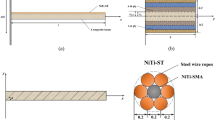Abstract
A serious of experimental tests on a commercial brass reinforced PZ bimorph cantilever of the type 5H4E were carried out in a vibration laboratory using a Labview of NI make as instrumentation and control system. Originally the bender acted as a tunable PZ generator, using perforated steel shims as a proof mass. The generator was converted to a hybrid generator by adding ring magnets to its other surface and making them working as part of an electromagnetic generator in addition of being a proof mass. Two arrangement of the electromagnetic generator were investigated at a frequency of (33) Hz which is the resonance frequency at max power of the original PZ generator. By using a shaker the cantilever was vibrated and set into acceleration of (0.25) g rms during all stages as this value was considered to be available and acceptable in balanced large rotating machines in industry. The hybrid generator produced (187) μW for max power, (14.8) Vrms for max OCV, and (8.26) Vrms for max on load voltage for the PZ part, while the electromagnetic part produced max (70) Vrms, (490) μW for arrangement (1) and (34) Vrms, (116) μW for arrangement (2) on no load condition and at the same frequency. The experimental results obtained from the electromagnetic generator are acceptable compared with theory.











Similar content being viewed by others
References
Amazing magnets (2010) Magnetization options. Amazing magnet web. http://www.amazingmagnets.com/t-mangetizationoptions.aspx. Accessed 3 March 2012
Anton SR, Sodano HA (2007) A review of power harvesting using piezoelectric materials (2003–2006). Smart Mater Struct 16:R1–R21
Arnold D (2007) Review of microscale magnetic power generation. IEEE Trans Magn 43:3940–3951
Beeby SP, Tudor MJ, White NM (2006) Energy harvesting vibration sources for Microsystems applications. Meas Sci Technol 17:R175–R195
Cheng S, Natarajan RD, Arnold DP (2010) The importance of coupling strength for maximizing the output power of electrodynamic vibrational energy harvesters. Proc Power MEMS 2010:351–354
Glynne-Jones P, Tudor MJ, Beeby SP, White NM (2004) An electromagnetic vibration powered generator for intelligent sensor systems. Sens Actuator A 110:344–349
Jeon YB, Sood R, Jeong JH, Kim S (2005) MEMS power generator with transverse mode thin film PZT. Sens Actuator A 122:16–22
Kim H, Tadesse Y, Priya S (2009) Piezoelectric Energy Harvesting. In: energy harvesting technology. Springer 2009:3–39
Luschas L, Kozinsky I, Kuligovszky, Illing M (2009) Effect of wire gauge in electromagnetic power harvester. Power proceeding MEMS 2009 proceeding, pp 380–383, Washington
Mitcheson P, Miao P, Start B, Yeatman E, Holmes A, Green T (2004) MEMS electrostatic micro-power generator for low frequency operatio. Sens Actuator A 115:523–529
Priya S (2007) Advances in energy harvesting using low profile piezoelectric transducers. J Electroceram 19:165–182
Ralib AA, Nordin AN, Salleh H (2011) A comparative study on MEMS piezoelectric microgenerators. Microsyst Technol J. doi: 10.1007/s00542-010-1089
Roundy S, Wright PK (2004) A piezoelectric vibration based generator for wireless electronics. Smart Mater Struct 13:1131–1142
Roundy S, Wright PK, Rabaey J (2002) Micro-electrostatic vibration-to-electricity converters. Proceedings of the ASME 2002 International Mechanical Engineering Congress and Exposition
Roundy S, Wright PK, Rabaey J (2003a) A study of low level vibrations as a power source for wireless sensor nodes. Comput Commun 26:1131–1144
Roundy S, Wright PK, Rabaey JM (2003b) Energy Scavenging for Wireless Sensor Networks. Kluwer Academic Publishers, London
Salim MD, Hanim S, Salim DS (2012) Simulation and experimental investigation of a wide band PZ MEMS harvester at low frequencies. Microsyst Technol J. doi:10.1007/s00542-012-1453-9
Sodano H, Inman DJ, Park G (2004) A review of power harvesting from vibration using piezoelectric materials. Shock Vib Digest 36:197–205
Sodano H, Inman D, Park G (2005) Generation and storage of electricity from power harvesting devices. J Intell Mater Syst Struct 16:67–75
Spreemann D, Folkmer B, Manoli Y(2008) Comparative study of electromagnetic coupling architectures for vibration energy harvesting devices. In: Tech. Dig. 8th Int. Workshop on Micro and Nanotechnology for Power Generation and Energy Conversion Apps., pp 257–60, Sendai, Japan
Williams CB, Yates RB (1996) Analysis of a micro-electric generator for microsystems. Sens Actuator A 52:8–11
Wischke M, Woias P (2008) A multi-functional cantilever for energy scavenging from vibrations. Proceedings of Power MEMS 2008, Sendai, Japan
Wischke M, Masur M, Woias P (2009) A hybrid generator for vibration energy harvesting applications. Solid-State Sensors, Actuators And Microsystems Conference 2009: Tranducers International, pp 521–524
Acknowledgments
This research was supported by a grant from Tenaga National Berhad Malaysia through Universiti Tenaga National.
Author information
Authors and Affiliations
Corresponding author
Rights and permissions
About this article
Cite this article
Salim, M.D., Salleh, H. & Salim, D.S. A low frequency tunable hybrid generator. Microsyst Technol 19, 1839–1844 (2013). https://doi.org/10.1007/s00542-013-1739-6
Received:
Accepted:
Published:
Issue Date:
DOI: https://doi.org/10.1007/s00542-013-1739-6




